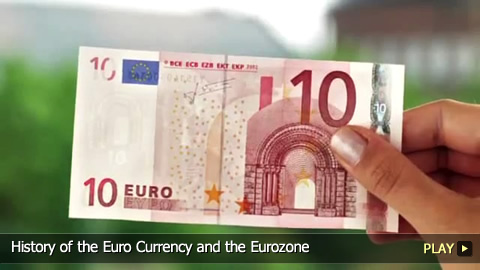History of the Euro Currency and the Eurozone

advertisement
VOICE OVER: Rebecca Brayton
Europe has a long and illustrious history as one of the world's largest trading zones; however, that trade was made more complicated by the differences between national currencies. For decades, it was suggested that a shared economic and monetary system would benefit Europe, and eventually the idea for a common currency developed as well. The bold Maastricht Treaty of 1992 created the European Union and set a deadline of 1999 for the introduction of that common currency. The euro arrived on schedule, and proved very successful in its early years. It was only during the 2007-2008 world financial crisis that it has been called into question. In this video, http://www.WatchMojo.com tracks the history of the euro.
The History of the Euro
This is Europe’s most significant monetary reform since the Roman Empire. Welcome to WatchMojo.com, and today we’ll be learning more about the history of the euro.
Euro and Eurozone
The euro is the form of currency used by the ever-evolving eurozone countries. The eurozone consists of countries from the European Union that adopted the euro as their common currency and only legal tender.
Historically Fragmented Currencies
While the euro was officially introduced on January 1st, 1999, the idea behind this common currency dated back decades. Historically, Europe was one of the world’s largest trading regions, but that trade was complicated by fragmented currencies.
League of Nations
As early as 1929, the League of Nations contemplated an economic and monetary union; however, World War II derailed those ambitions.
European Coal and Steel Community
During the Cold War, efforts to strengthen ties between noncommunist nations were made: 1951’s Paris Treaty linked Belgium, France, West Germany, Italy, Luxembourg and The Netherlands and created the European Coal and Steel Community.
European Economic Community
Those six countries signed the Treaty of Rome in 1958 to found the European Economic Community, which was a precursor to the European Union. The idea of economic cooperation eventually resurfaced: a report published in 1970 suggested the centralization of financial policies in Europe. This set the wheels in motion for a single European currency and central bank.
European Monetary System
In 1979, most of the EEC nations instituted the European Monetary System to stabilize exchange rates and offset inflation of the newly-created European Currency Unit or ECU.
Single European Act
Much of the 1980s was spent realistically planning the establishment of the economic and monetary union. 1986’s Single European Act augmented cooperation between the EEC nations in terms of politics and economics.
The Maastricht Treaty
The bold Maastricht Treaty was signed February 7th, 1992, and it was this accord that created the European Union. It also established 1999 as a deadline for the creation of common currency, and set the basis for the shared financial strategy. Countries were required to meet stringent criteria in order to sign the agreement: low budget deficits and debt ratios were just some of the required measures.
European Monetary Institute
The groundwork for the euro was laid during the 1990s: the European Monetary Institute replaced the EMCF in 1994, and became the prototype for the European Central Bank.
UK, Denmark, Sweden Opt Out
The currency’s name “euro” was chosen in December 1995. As many countries endorsed it to their populations, the United Kingdom, Denmark and Sweden eventually decided to opt out of its use, and kept their own currencies.
Conversion
Each participating nation’s currency was converted to the euro via triangulation. This negated discrepancies between the various countries’ standards for rounding and important numbers. It was finally determined in December 1998 that one ECU would equal one euro.
Euro Introduced
The euro was first circulated on January 1st, 1999 in non-cash transactions and accounting: for example, traveler’s checks, stocks and mortgages were all available in euros. The national currencies of the eurozone countries were then discontinued and established at fixed rates with each other.
Transition Until 2002
The changeover to the euro was a three-year transition: paper money and coinage from the old system was accepted until 2002, at which point enough euro notes and coins had been produced.
Initial Performance
After its launch, the euro performed better than expected: it opened trading on January 5th at 1.19USD. Dealers were amazed by how quickly it replaced the national currencies; for example, the mighty Deutsche Mark was predicted to trade in parallel, but it disappeared immediately.
Evolution of the Eurozone
Following the introduction of this currency, the eurozone expanded and changed significantly: Greece qualified for membership in 2001, and more nations joined in the years that followed.
Financial Crisis
As the world experienced a financial crisis in 2007-2008, so did the eurozone. Problems in Europe stemmed from the strict guidelines member countries were expected to adhere to, and from the over-optimistic idea that the work ethics and viewpoints on debt of these countries would converge over time.
A Lasting Solution?
Aside from strengthening ties between eurozone countries, the euro helped increase tourism within that area. Time will tell if this currency reform is a lasting solution.

